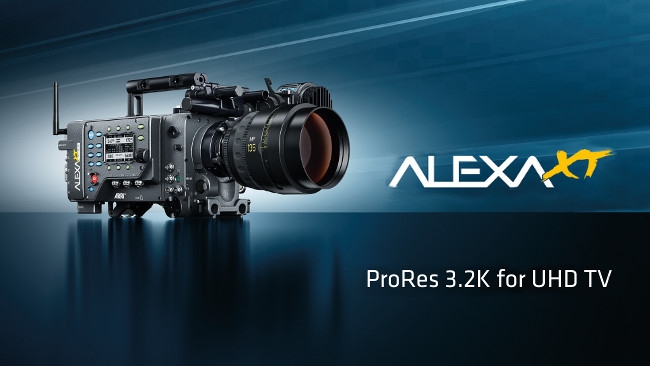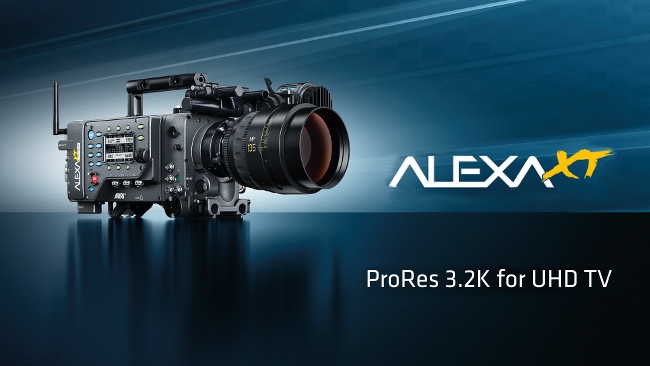
 Arri Alexa XT
Arri Alexa XT
ARRI makes it clear that the Alexa is a camera for the 4K future
ARRI have made a very interesting announcement. Early next year (2015) they will be releasing a firmware update to allow the Alexa XT to record in 3.2K directly to Apple ProRes format. When it was announced that the Amira would record to ProRes at UHD resolution a few days ago I was left wondering what ARRI had in mind for the Alexa. It seemed strange that they would release such an update for the Amira and not for the Alexa also. This made me wonder if they had something up their sleeve for the Alexa too. Well now we know what they had in mind!
It appears that the Alexa XT update will differ from the Amira update by recording directly to 3.2K ProRes whereas the Amira upsamples the 3.2K to the 3.8K of UHD in camera. I assume this difference in workflow is because the Amira is more geared up for the output to be largely ready to go right out of the camera. On the Alexa XT you lose that advantage but gain the advantage of having smaller ProRes files to work with and archive and also the possibility of using your favourite upsampling algorithm and the choice of whether to upsample to UHD TV or all the way to cinema resolution 4K.
Until now if you wanted to record at resolutions higher than 2K on the Alexa XT you had to commit to recording in ARRIRaw with the workflow that required but now the Alexa XT will be even able to record in 3.2K direct to ProRes.
Another perhaps unplanned advantage of the Alexa XT recording in 3.2K, is that it is quite clear that this is actual native resolution that is available from the camera and that it isn’t just being upsampled from 2K (which a lot of people assumed would be the case with the Amira UHD update).
ARRI point out that this will future proof any content you shoot for the future so that you can shoot now but re-release your movie or other production in the future on a UHD-TV format of some kind. They are also keen to mention in their press release that the Alexa is also well suited to produce content that will work with future Dolby high dynamic range formats and they are working closely with Dolby to make sure the Alexa will be a good match for this technology as well.
As people often point out, we are still a way away from these future technologies being anything like widespread, so for now it’s about recording content that can continue to be easily re-purposed in the future. This new update for the Alexa should make that easier and more economical.
Check out the full press release after the break:
NEW ALEXA PRORES 3.2K FOR UHD DELIVERABLES
(September 2nd 2014, Munich) – ARRI today announces ProRes 3.2K, a new recording
format for its ARRI ALEXA cameras that will become available through a software
update scheduled for release early next year. ProRes 3.2K allows the same easy up-
sampling in post to UHD deliverables as ARRIRAW Open Gate does to 4K. These
formats, combined with ALEXA’s unsurpassed dynamic range, make the camera
suitable for any type of production with any distribution requirements.
ALEXA is Future Proof
The majority of digital film and television productions continue to capture, postproduce
and distribute in HD or 2K, formats for which ALEXA provides an unmatched solution.
Widespread adoption of UHD/4K post workflows, as well as availability of UHD displays
in consumer homes and 4K projection in movie theaters is at least one to two years
away – even in the most progressive markets. However, some film and program makers
are already concerned about protecting their work for future developments. The ongoing
debate regarding high dynamic range (HDR) displays, which have an even greater effect
on viewing experience than higher spatial resolution, only adds to these concerns.
ALEXA Product Manager Marc Shipman-Mueller comments, “Designed from the outset
to be adaptable and future-proof, ALEXA can easily accommodate productions that
choose to follow a UHD or 4K workflow. The camera's stellar overall image quality in
combination with ProRes 3.2K or ARRIRAW Open Gate allows for simple up-sampling
to UHD or 4K in a quality at least as good as other contenders. And because of their
unequalled exposure latitude and highlight handling, ALEXA images are already
uniquely HDR-compatible. Put simply, ALEXA remains the safest available capture tool
for asset longevity, no matter what future standards come to fruition.”
Capture with ALEXA, Deliver UHD for Television
For TV productions looking for a UHD deliverable, ALEXA XT cameras and ALEXA
Classic cameras with the XR Module upgrade offer the new and cost-efficient ProRes
3.2K recording option. At data rates far below uncompressed ARRIRAW, ProRes 3.2K
provides the benefits of the well-established and efficient ProRes workflow. As an
additional benefit, most lenses fully cover the 3.2K image circle that results from the 16:9
ProRes 3.2K image. A straightforward up-sample from ProRes 3.2K using standard post
tools delivers UHD images of the highest quality for broadband and broadcast.
Capture with ALEXA, Deliver 4K for Feature Films
Many high-profile movies have been shot in ARRIRAW 2.8K and up-sampled to a 4K
DCP with spectacular results, an example being the last James Bond film, Skyfall. To
further improve upon this option, ARRI introduced the ARRIRAW Open Gate recording
format for ALEXA XT cameras earlier this year. Open Gate records the full 3.4K ALEXA
XT sensor area for an optimal up-sample in post to a 4K DCP.
Open Gate has been enthusiastically received by the feature film industry and is
in use on numerous productions already, including Warcraft, San Andreas, Pixels,
Goosebumps and Sicario, the latest movie lensed by Roger Deakins, ASC, BSC. Other
feature films are shooting ARRIRAW 16:9 or ARRIRAW 4:3 and using Open Gate
selectively for VFX shots, including Terminator: Genesis, Fantastic 4, Agent 47 and
Deus Ex Machina.
Capture with ALEXA, Protect for HDR
Recent demonstrations of high dynamic range (HDR) displays have shown the
extraordinary visual impact of increased dynamic range and sparked a debate over how
and when they will be introduced. ARRI has been working with Dolby at major trade
shows to help showcase Dolby® VisionTM display technology, which is capable of 100
times more brightness than a conventional TV. This has contributed to a spreading
awareness in the industry that dynamic range is an even more important factor than
spatial resolution in creating a superior visual experience. Recognizing this, other
companies such as Thomson, Philips and the BBC are working on their own HDR
solutions.
ALEXA's unrivalled exposure latitude, highlight handling and color science already result
in images beyond the capabilities of current display technologies. The Dolby Vision
presentations have revealed how much better ALEXA images look when displayed
with extended dynamic range, proving the enormous and as-yet untapped potential of
ALEXA-originated material to be remastered for future HDR display standards.
About ARRI:
With headquarters located in Munich, Germany, Arnold and Richter Cine Technik (A&R) was founded in 1917 and is the
world's largest manufacturer and distributor of motion picture camera, digital intermediate (DI) and lighting equipment.
The ARRI Group comprises a global network of subsidiaries and partners that covers every facet of the film industry,
including worldwide camera, grip and lighting equipment rental through ARRI Rental; turnkey lighting solutions through the
ARRI System Group; lab services, postproduction and visual effects through ARRI Film & TV; and film distribution through
ARRI Worldsales. Manufactured products include the ALEXA camera system and AMIRA documentary-style camera;
Master Anamorphic lenses; L-Series LED and M-Series HMI lights; Pro Camera Accessories; and ARRISCAN archive
technologies. The Academy of Motion Picture Arts and Sciences has recognized ARRI’s engineers and their technical
contributions with 18 Scientific and Engineering Awards.
For locations and more information please visit www.arri.com
Tags: Technology



Comments